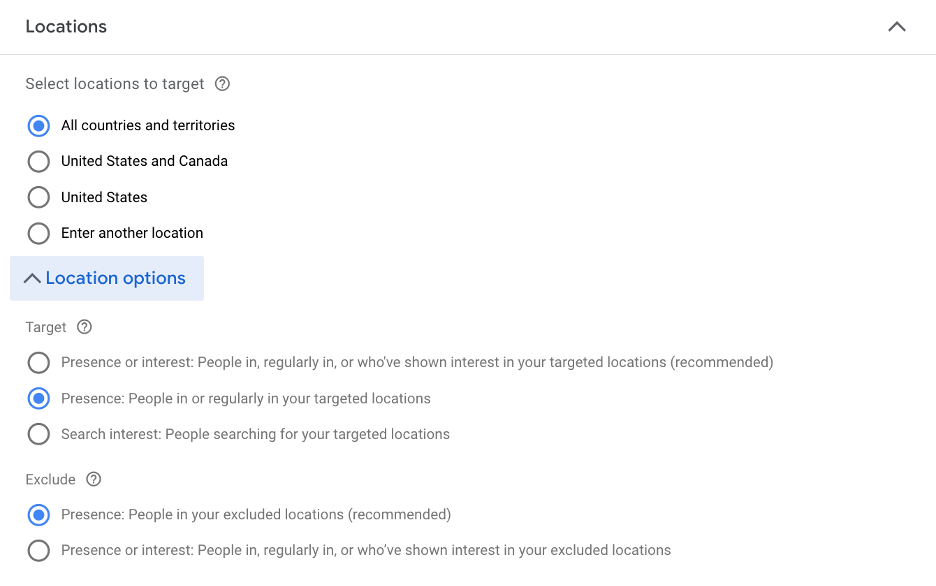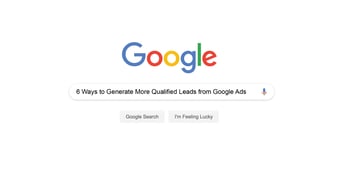
Search engine advertising can be a fun and challenging aspect of marketing to get started with. To get the most out of your paid advertising investment, however, you need to get the most eyes possible on your ads. As you create your Google Ads, there are some common mistakes you should avoid so your business can appear prominently in search engine results.
Incorrectly Selecting Advanced Location Options
In the beginning stages of campaign setup, you’ll choose the locations you wish to target. Underneath the standard targeting options are also location options. Incorrect selection can have a lasting impact on your campaigns.
Click the drop-down arrow to reveal your location options. By default, the target will be set to presence or interest, which includes people who live in, are regularly in, or have shown interest in your targeted locations. If you are a local locksmith in Birmingham, Alabama, then keeping this option selected is a mistake that will spend your daily budget quickly while driving poor-quality traffic to your site. In this case, only presence should be selected. That way, your ads show only for audience members who are regularly in Birmingham, Alabama, and not for those who live in different locations but have shown interest in the area.

On the other hand, if you own a car rental company in Marco Island, Florida, you’d likely want to capture the attention of those who’ve shown interest in Marco Island because it’s a popular vacation spot, and it’s not uncommon for your customers to book a rental car prior to their arrival. In this case, it would be a mistake to select presence for your target option because you might miss attracting audience members who don’t live in your location. Running a custom report in your Google Ads account can reveal any spend accidentally allocated to inappropriate location targets.
Tracking Daily Performance Too Closely or Making Campaign Updates Too Often
If your campaign is performing poorly, it might be tempting to make updates often and track changes daily. However, you can’t effectively measure performance if you’re making changes every day. Updating settings every time your campaign’s performance underwhelms you will slowly kill your campaign.
Changes to Google ad campaigns need time to show results, especially if you’re utilizing a Smart Bidding strategy. You need data to make good decisions, and you need to know what the data means. Focus on longer-term campaigns or overall business goals; if you’re positively moving towards them and improving over time, then daily ad performance is less important. It’s easy to get caught up in the day-to-day management of an ad campaign vs. letting the algorithm do its thing, but Google states that it takes about two weeks for the campaign to learn and fully optimize after editing Smart Bidding settings.
As a general rule, larger changes (like to your bid strategy) need at least 14–21 days to adapt before you should make any additional updates. Smaller changes (like adding negative keywords) to a campaign need at least 5–7 days to adapt. It’s also helpful to make all campaign changes on the same day of the week. This prevents you from making small incremental changes day by day, which makes it difficult to determine what causes shifts in performance. Ultimately, any changes you make to your campaigns should not be rooted in panic or desperation. Before making a change, clarify the why behind it.
Incorrect Use of Expanded Targeting Options
In the beginning stages of campaign setup, you will also make your audience segment selection. You’ll find two selections for this setting: targeting and observation. By default, the observation setting will be selected, which is beneficial if you want to discover and monitor new audience segments—but not if you’re utilizing a targeted audience strategy.
To target only your chosen audience(s), use the targeting setting. This is essential if you want to speak directly to specific audiences or run a retargeting campaign, since the main purpose of retargeting is to show your ads to users who already have a relationship with your business.

On the other hand, the observation setting will allow you to observe how certain criteria perform with your campaign without actually adding those criteria. This setting is typically most useful for search campaigns but should especially be avoided if you’re working with a smaller budget. The insights you receive from the observed segments can then be used to guide further campaign actions. The best way to avoid this mistake is by learning the use cases for each targeting setting. Remember that the audience segments available to you will depend on the type of campaign you select, and you can always create custom audience segments if needed.
Over-Utilizing One Keyword Match Type
It’s common to prefer one keyword match type over another. This is especially true if you see more success or feel more comfortable with one type. While Google often stresses broad match keywords, broad match doesn’t apply to every campaign and may even be detrimental to certain campaigns or ad groups.
By default, Google designates new keywords as broad match type. Broad match keywords will help your site appear in the largest number of searches, but you’ll have the least amount of control over what keywords your ad shows up for. For this reason, when using a broad match strategy, it’s vital to check the search terms report often and use negative keywords to eliminate irrelevant searches and minimize wasted spend. When paired with an appropriate smart bidding strategy, broad match keywords can generate more volume with more conversions.
Exact match keywords will give you the most control possible over the keywords your site shows up for, but you will reach fewer users. This keyword match type can still be useful for lower-budget campaigns that require hyper-relevancy. However, if you’re only using exact match for your keywords, you could be missing out on potential customers who are searching using synonyms, related terms, and misspellings of the words that describe your products or services.
Setting keywords to phrase match can be tempting because you might assume it will catch everything. However, it might be worth testing out all three types to see how they perform relative to each other. Phrase match will reach more searches than exact match but fewer than broad match. Broad match will be weighted heavier than phrase or exact match because it allows you to be very specific while still allowing Google to apply some of its own logic based on what words in the query are present in your ad’s text. While broad match may provide the most accurate results in terms of what a user is looking for, there’s no guarantee that your ad will be served up when someone searches for those terms (or even close variations). This means that using phrase and exact matches in addition to broad match can help ensure that your ads will show up at the right time.
In Conclusion
Running a successful Google Ad campaign requires careful planning, proper execution, and continuous monitoring and optimization. While many mistakes can be made along the way, those discussed in this article are among the most common, and you can easily avoid them with research and due diligence. By understanding these pitfalls and taking the necessary steps to avoid them, you can ensure your Google Ad campaign is set up for success and your advertising budget is being used effectively to reach your target audience.


